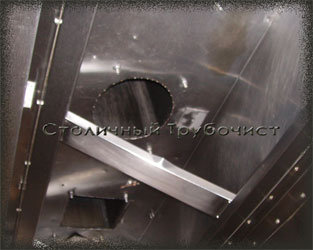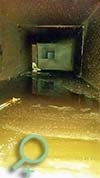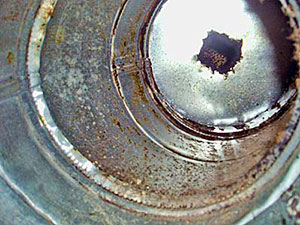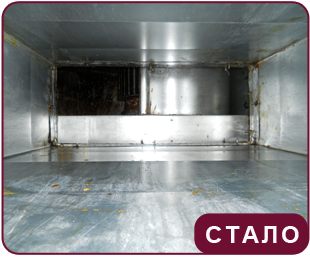Professional cleaning of ventilation from fatty deposits by specialists of the Plast Group company. Cleaning of ventilation from dust.
Reasons for degreasing ventilation systems
In the absence of timely cleaning of the ventilation of the hot shops of restaurants and canteens, the work is deteriorating exhaust system ventilation, which leads to an increase in the content of foreign odors in the air. And this leads, first of all, to a deterioration in the well-being and mood of visitors and staff, and a decrease in efficiency. Over time, grease accumulates on the surface of the ventilation ducts, which reduces ventilation performance. It also increases the likelihood of a serious fire due to ignition. exhaust ventilation.
Therefore, regular cleaning of ventilation systems from grease is necessary. Regular cleaning of ventilation systems from fatty deposits reduces the risk of a fire hazard, makes the system more compliant with sanitary and epidemiological standards and significantly increases its productivity and quality of work. Cleaning frequency ventilation system is determined individually, depending on the scope of the enterprise and the wishes of the customer, usually at least once every six months. For continuous food processing plants or other enterprises that actively use the ventilation system, the necessary frequency of cleaning can be up to two to three times a month.
At the moment, regular cleaning of ventilation systems from fat deposits is a mandatory norm, compliance with which is monitored by state inspection bodies. Moreover, many insurance companies include in their insurance contract a mandatory clause on regular cleaning of ventilation systems.
Restaurants, cafes and other catering establishments
In the smoke channels of restaurant and table stoves, greasy soot is formed, which is a fire hazard, as it burns with the formation of a flame and release a large number heat (25373 kJ/kg). The ignition temperature of greasy soot is only 250°C. The burning of soot in the channels is accompanied by the release of a large number of sparks and an increase in temperature in the channels up to 1000 degrees.
A feature of some catering establishments is the use of barbecues and wood-burning grills for cooking. This kind of open flame sources impose special requirements on exhaust ducts. During operation, a mixture of soot and fat is deposited, which can lead to both damage to the fan and a fire, since the resulting mixture is flammable. 1000°C. 
Technical solutions to such problems are the use of special grease filters, the design of exhaust ducts in accordance with established standards with the possibility of their periodic opening and cleaning, and the installation of protected exhaust fans.
Dust and grease deposits accumulate in ventilation equipment and air ducts, which narrow the air ducts, preventing normal air exchange, which often leads to disruption of the technological process. They can become a source of fire, which will instantly spread through the ventilation system of the building. Besides, body fat- a nutrient medium for bacteria, fungi, dust mites and other microorganisms.
Servicing and cleaning the ventilation systems of cafes and restaurants from dust and grease will avoid these consequences, maintain the efficiency of ventilation and increase the life of expensive ventilation equipment. The frequency of these works is established jointly with the engineering services of enterprises and ranges from 1-2 times a year to 1-2 times a month, depending on the purpose.
Many insurance  companies must include in the contract for insurance of food industry and public catering enterprises, a condition on the mandatory cleaning of ventilation systems in accordance with the standards and operating conditions.
companies must include in the contract for insurance of food industry and public catering enterprises, a condition on the mandatory cleaning of ventilation systems in accordance with the standards and operating conditions.
Unfortunately, many catering enterprises neglect these standards, if they clean the hood from grease and clean the air ducts, then when fat and soot ignite in the exhaust ducts or when the air ducts become so dirty that they stop working.
Of course, there are restaurants that carry out regular maintenance by cleaning the hood from grease and soot, and control the condition of all components of the exhaust system. But there are very few such companies.
Building operators and owners are aware of the importance of proper maintenance of ventilation systems. But no one wants customers to know about it. In this case, you will have to allocate additional funds for maintenance and cleaning. The ventilation system requires serious cleaning every 3 years. As for catering establishments, they must clean the hood from fat and soot at least once a month!
According to statistics, only about 5% of organizations are seriously concerned about the state of ventilation systems.
Ideally, all enterprises and institutions should have a contract for the maintenance of ventilation with specialized enterprises.


Fire safety chimneys is ensured by the use of pipes of appropriate materials, the installation of fire-fighting retreats of the required dimensions, the presence of devices for cleaning channels and pipes from soot, the installation of pipes, taking into account the Rules for the production of pipe and furnace works and other regulations.
Installation and operation of smoke and exhaust ducts, cleaning of the hood from grease must be carried out in accordance with the rules set forth in the basic regulations: SNiP 41-01-2003 "Heating, ventilation and air conditioning", manual 13.91 to SNiP 2.04.05-91 "Fire requirements to heating, ventilation and air conditioning systems", NPB 105-03 "Fire safety standards", Rules for the production of pipe and furnace works of the VDPO. There are also a number of standards for design, for the quality of exhaust air, hygiene requirements to protection atmospheric air settlements (SES), etc.
 About galvanized pipes
About galvanized pipes
For some reason, it is sometimes believed that galvanized pipes are good to use in smoke exhaust systems. But in general, you can't do that. The reason is that under the influence of temperatures typical for heating systems, the reaction Zn + H2O = ZnO + H2 occurs. Simply put, the zinc layer is destroyed, and hydrogen accumulates in the pipes, preventing the system from functioning normally. It should also be taken into account that galvanized pipes cannot be used in heat supply systems due to the destruction of the zinc coating when exposed to high temperatures. Galvanized steel is used only for the outer contour of the sandwich chimneys. It is impossible to make exhaust hoods over heat units and a chimney circuit that carries a thermal load from galvanization, because. when heated strongly, it releases zinc oxides, which are very harmful to health.
Small excerpts from the above documents:
From SNiP 41-01-2003
4.4.4 Thermal insulation of heating and ventilation equipment, pipelines of internal heating systems, air ducts, chimneys and chimneys should be provided for:
to prevent burns;
to ensure less than permissible heat losses;
to prevent moisture condensation;
to prevent freezing of the coolant in pipelines laid in unheated rooms or in artificially cooled rooms.
The surface temperature of the thermal insulation must not exceed 40 °C.
Hot surfaces of heating and ventilation equipment, pipelines, air ducts, chimneys and chimneys located in rooms where they create a risk of ignition of gases, vapors, aerosols or dust should be insulated, providing for a temperature on the surface of the heat-insulating structure at least 20 ° C lower their ignition temperature. Heating and ventilation equipment, pipelines and air ducts should not be placed in the specified premises if there is no technical possibility to reduce the temperature of the thermal insulation surface to the specified level. Thermal insulation structures should be provided in accordance with SNiP 41-03.
7.1.13 In local suction systems, the concentration of removed combustible gases, vapors, aerosols and dust in the air should not exceed 50% of the NKPP at the temperature of the mixture being removed.
7.11.4 Air ducts made of non-combustible materials should be designed:
A. for systems of local suctions of explosive and flammable mixtures, emergency and transporting air with a temperature of 80 ° C and above;
b. for sections of air ducts with a standardized fire resistance limit;
V. for transit sections or collectors of ventilation systems, residential, public, administrative and industrial buildings;
g. for laying within the premises for ventilation equipment, as well as in technical floors, attics, basements and undergrounds.
7.11.5 Air ducts made of combustible materials P may be provided in one-story buildings for SNiP 41-01), residential, public, administrative and industrial premises category D, except for the systems specified in 7.11.4 a), b) and d) and premises with mass stay of people.
7.11.6 Air ducts made of combustible materials may be provided within the serviced premises, except for air ducts specified in 7.11.4. Flexible inserts and outlets made of combustible materials in air ducts of systems serving and passing through rooms of category D may be designed if their length is no more than 10% of the length of air ducts made of combustible materials P and no more than 5% for air ducts made of non-combustible materials. Flexible connectors for fans, except for the systems specified in 7.11.4 a) and b), may be designed from combustible materials.
10.7 Emissions from exhaust ventilation systems should, as a rule, be designed separately if at least one of the pipes or shafts can deposit combustible substances or if mixing of emissions can form explosive mixtures. It is allowed to connect such emissions into one pipe or shaft, providing for vertical cuttings with a fire resistance limit of 0.5 hours from the point of connection of each air duct to the mouth.
From the fire safety rules in the Russian Federation (PPB 01-03):
……….
67. It is necessary to clean chimneys and stoves from soot before the start, as well as during the entire heating season at least:
once every three months for heating stoves;
once every two months for furnaces and continuous hearths;
once a month for kitchen stoves and other continuous (long-term) furnaces.
……….


VENTILATION FOR CAFE AND RESTAURANTS
Grease ventilation cleaning.
Why is it necessary?
THE REPRESENTATIVE OF THE CUSTOMER IS SHOCKED WHEN SEEING WHAT WAS IN THE VENTILATION CHANNELS OF THE RESTAURANT VENTILATION SYSTEM.
The fat ventilation system of a restaurant or cafe consists of three main elements:
- Exhaust hood (local suction) - one or more;
- Air duct - it can be round or rectangular;
- Ventmashina - axial fan, duct fan, snail and their varieties.
Hood cleaning

Daily fat removal visible surfaces of the exhaust hood, or local suction, and grease traps, as a rule, are made by kitchen workers. They do less cleaning inner surface umbrellas behind grease bars.
If this work is not performed on its own or is not performed in full, then the cleaning of the umbrella is included in the terms of reference for the performance of work on cleaning the grease ventilation by the specialists of the service company.
Cleaning the dressing umbrella is necessary not only for aesthetic reasons, but also for normal operation grease gratings.
The inner surface invisible behind the gratings must be cleaned of fat deposits due to their high fire hazard.
The exhaust hood is the hottest part of the ventilation system, often in contact with an open fire from the oil that flared up when cooking in an overheated pan.
Cleaning of ventilation ducts
The intensity of fat deposits in the ventilation duct is decreasing from the umbrella to the ventilation machine. Deposits do not affect the capacity of the ventilation duct ( channel for example 400mm / 300mm, and deposits 20mm), but are just as fire hazardous as an exhaust hood, especially in areas adjacent to it, due to the high temperature.
The second trouble caused by the presence of deposits in the air ducts- this is the leakage of fat from the joints of the boxes due to their leakage. This can be seen from the drops of fat dripping from the ceiling. First aid is to put a tray under the "drops", which is done in many cases.



The problem can be cardinally solved only by cleaning the air ducts from fatty deposits.
It is not possible to clean the air duct from fatty deposits on its own without a significant investment of time. This work is carried out with the help of special devices and expensive equipment.
Cleaning the ventilation machine
The fan not only creates air movement in the ventilation system, but also “grinds” it. As a result, fat deposits accumulate on the fan blades.



According to the laws of aerodynamics, any contamination, an increase in roughness, a change in the geometry of the blades due to sticking of fat, leads to a decrease in performance. ventilation unit. As the layer of fat on the blades of the ventilation machine increases, the weight of the impeller increases, and the fat falling off in places under the action of centrifugal force from individual blades leads to an unbalance of the fan.
Due to imbalance, the speed of the electric motor drops and, overheating, it fails, but simply - the ventilation machine burns out.
From this it follows that the timely cleaning of the ventilation machine from fatty deposits has the maximum effect on its performance in terms of pumped air and, consequently, on the performance of the entire grease ventilation system as a whole.
And of course the resource of the fan motor also matters. The thing is not cheap in itself, and even the work of replacing it costs money.
If the material seemed useful to you, share the link with your friendsFIRE HAZARD -
THE MAIN REASON FOR GREASE VENTILATION CLEANING
IN CAFE AND RESTAURANTS
Fat deposits practically do not affect the throughput of the ventilation system, but the oil-like film formed by them on the equipment causes fires and burnouts of air ducts.

In some cases, the cleaning interval for individual elements of the grease ventilation system may be changed by the standards and regulations of the State Fire Supervision Service.
ON SITE TODAY

"Dry cleaning of ventilation"
timely cleaning ventilation from grease and no problems with Rospotrebnadzor!
Ventilation systems of food industry enterprises, cafes and restaurants quickly become contaminated with fatty deposits. Complete cleaning of ventilation from grease should be carried out at least once a quarter. Otherwise, the inspection of the Ministry of Emergency Situations or Rospotrebnadzor will end with a large fine. Employees of the regulatory authorities will oblige the management to eliminate the detected violations and, if this requirement is not met on time, they may suspend the organization's activities for up to 3 months.
Failure to clean the ventilation from grease in a restaurant leads to serious losses - a temporary closure will lead to a loss of reputation and regular customers. Accumulations of grease increase the risk of fire in the ventilation system. Due to the fact that the cleaning of the ventilation from grease in the restaurant was not completed on time, the institution may close forever. Call our company to avoid claims from regulatory authorities and take care of fire safety - after the technician finishes cleaning, these problems will be solved!
After the cleaning of the fat ventilation is completed, the technician hands over the documents to the client for presentation to the employees of the Ministry of Emergency Situations or Rospotrebnadzor. The customer is also provided with a video report on the work done.
There are several methods for cleaning grease from ventilation ventilation - the most suitable method for removing grease is selected by our technician, taking into account technical features ventilation systems and enterprise activities. Our employee is using special devices, including a brushing machine, as well as chemicals that completely remove grease from the inner surface of the components of the ventilation system. Comprehensive cleaning of ventilation from grease includes the processing of all ventilation elements: umbrellas, hoods, channels, extractors and other equipment.Cooperation proceeds according to the following scheme:

the customer calls a technician to the facility to assess the amount of work;
a specialist inspects ventilation;
a contract is concluded with the client;
the technician arrives at the appointed time and does his job;
the customer is provided with a certificate of completion and other documents.
The need for
Especially relevant is the cleaning of ventilation from fat in a restaurant where the cooking process is ongoing. Deposits on the walls of communication boxes become a fertile environment for the emergence of various dangerous bacteria that can get into food. Professional air purification will not only get rid of this problem, but also make the atmosphere in the institution more pleasant and comfortable.
For catering establishments, cleaning the ventilation from grease is an extremely important task. Fat, settling on the walls of the air ducts and collecting flying dust, over time significantly reduces the cross-sectional area of the air duct. It creates increased aerodynamic drag in the system. To overcome it, additional energy costs are required. Cleaning of ventilation systems from grease is needed not only for this reason. The dust-fat mixture is an ideal substrate for the propagation of pathogenic microorganisms that can get on food from the ventilation of restaurants and cafes. This, in turn, can lead to non-compliance of the institution with sanitary standards.
However, such cleaning is a very difficult task. The fact is that fat is almost impossible to remove. mechanically. It is simply smeared with metal brushes along the walls of the air ducts. For this reason, today the grease cleaning of ventilation is carried out by a chemical method, as well as by wet or cryogenic methods. They provide excellent results. These methods differ in cost and in the thickness of the removed fat deposits.
Our experts recommend cleaning regularly, according to a predetermined schedule. This allows you to carry out the work as quickly as possible, and the customer saves not only time, but also money. If the grease cleaning of ventilation is carried out according to plan, the unpleasant consequences described above are excluded. In addition, you do not have to look for someone who will perform these works urgently. It is very difficult to find a company free of orders that will do the cleaning in 1-2 days.
As a rule, if the situation is not neglected, our company applies chemical cleaning. Such duct cleaning of ventilation systems consists in spraying a special aerosol chemical agent into a pressurized ventilation system. In this case, a powerful exhaust fan should be installed on the outlet. After that, the reacted fat deposits lag behind the walls. The air flow created by the fan removes contaminants from the ventilation system.
Cleaning ventilation from fat deposits by wet and cryogenic methods is more expensive and will take more time.
However, they make it possible to remove thicker deposits. In the first case, the fat is removed by a jet of a mixture of water and detergents supplied under high pressure. In the second case, dry ice is used, causing a microexplosion and separation of deposits. Using these methods allows you to increase the period between cleanings.
Our company has a staff of qualified personnel with experience in cleaning ventilation systems from fatty deposits. different thickness. We guarantee our clients high quality cleaning of ventilation systems in public catering establishments.
Cleaning the ventilation from dust
In buildings and structures in which there are no vapors of fats and oils, only periodic cleaning of ventilation from dust is required. For its implementation, mechanical cleaning using a special brush is sufficient. The dust left behind from walls is removed by the fan. The whole process is quite simple and does not require much time.
For some objects, for example, ventilation systems of industrial halls, mechanical cleaning must be carried out especially often. Increased dust formation leads to the fact that the air ducts become overgrown especially quickly, and the system ceases to cope with its functions. In this case, cleaning should be carried out according to the schedule, without waiting for the deterioration of the ventilation parameters.
The Five Elements company cleans ventilation from various deposits, including dust, in systems of any complexity. In addition, we can combine cleaning with Maintenance and minor repairs. This will make it possible to reduce the cost of these works and the number of days of idle ventilation to a minimum. Working with us guarantees you uninterrupted ventilation and high air quality.



